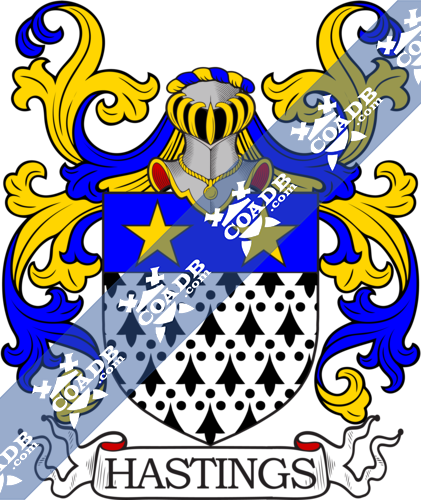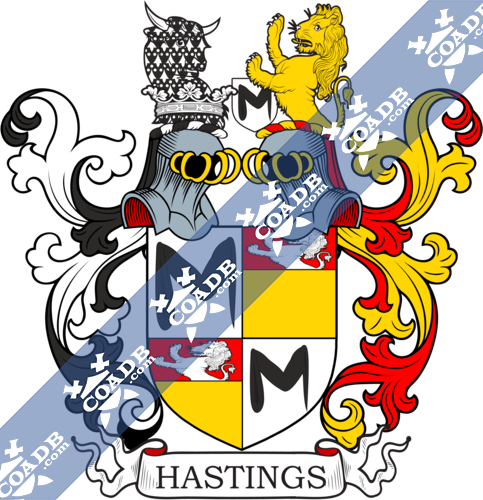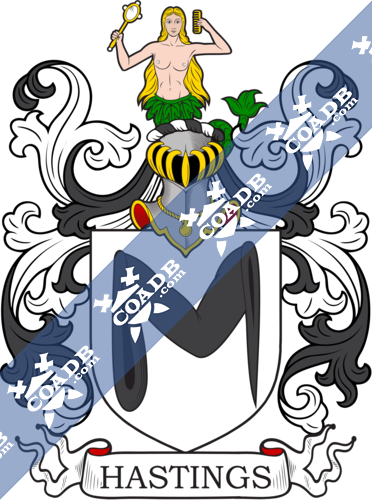Hastings Family Crest, Coat of Arms and Name History

Hastings Coat of Arms Gallery
Don’t know which Coat of Arms is yours?
We can do a genealogical research. Find out the exact history of your family!
Learn MoreHastings Origin:
England, Ireland, Scotland
Origins of Name:
The Hastings surname originates from 5th Century Norseman. Later from the name Hastein who was a Viking chief that raided several countries. Later, in England it would originate geographically from the town of Hastings, Sussex, England. The city of Hastings is named after the Hastingas tribe that invaded England during the Norman Conquests.
Variations:
More common variations are: Hasting, Hastings, Hastin, Hustin, Hustings
History:
England:
Hastings, Sussex, England was recorded as early as 790 A.D., however the surname was never recorded until the early 12th century.
During the Norman Conquests, Robert de Hasting was a commander in the army led by William the Conquerer in 1066. He led his army in the famous Battle of Hastings, and upon victory was given the town of Hastings by William the Conquerer and would become mayor. The noble families from the surname Hastings are descended from Robert de Hastings.
Another line of Hastings hails from Fillongley in Warwickshire. Supposedly this could be an earlier line than Robert de Hasting. It is noted that a powerful family o Hastings reigned here for many years.
The first known recorded instance of the name is of Robert de Hastin in 1130 in Leicestershire in the Pipe Rolls.
Henry de Hastings in 1235 was recorded, and he was made Baron in 1264 by Simon de Montfort. He fought in the Battle of Lewes and led the Londoners. John Hastings, Henry de Hastings’ son, fought in the wars of 1290s. Henry de Hastings’ grandson – John Hastings fought in the First War of Scottish Independence and would later become Govenor of Kenilworth Castle.
The surname Hastings is the 718th most common name in Great Britain. The highest concentrations are in East Lothian, Luton, Northumberland, Somerset, and Cheshire.
Ireland:
The surname Hastings is the Anglicized version of the Gaelic O’hoistin which means “descendant of Oistin”. Oistin was a Norse personal name. So the roots of the name in Ireland can also be traced back to Norsemen.
Scotland:
Scotland was also invaded by Vikings which settled there, and the surname could possibly originate solely from these Norsemen. However, it is also possible that immigrants from Hastings brought the surname with them to Scotland.
The first known instance of the surname Hastings was Norman Johanne de Hastinge in 1178. Norman de Johanne de Hastinge was the Lord of Duns and sheriff of the Mearns. He married Isabella de Valence, the niece of King Henry the 3rd.
United States:
In the 17th century various Hastings would arrive in the United States due to the Great Migration from Europe.
Thomas Hastings from Ipswich would sail aboard the Elizabeth and arrive in Watertown, Massachusetts in 1634. In 1635, Edward Hastings would settle in Island of Providence. One year later, William Hastings would land in Virginia in 1636. Finally, in 1659, Walter Hastings would arrive in Cambrigde Massachusetts.
The first instance of Hastings in the United States in the 19th century were three brothers John, James and Thomas Hastings who immigrated from Ireland in 1822. Hastings today can mainly be found in Georgia, Kentucky, Louisiana and Massachusetts.
Here is the population distribution of the last name Berry:
33,000 in the United States, 6,000 in England, 2,000 in Australia, 2,000 in Canada, 1,000 in Scotland
Notable People:
Bill Hastings (1888-1919), English professional soccer player. He scored 7 goals in 40 games with Birmingham. He later became a referee after retiring from soccer.
Clifford C. Hastings (1882 – 1946), New York politician. He was also an electrical engineer, businessman and politician. He remained in office as Treasurer of Rensselaer County from 1944 until his death.
Milo Hastings (1884 – 1957), American inventor. He was also an author and nutritionist. He invented various health food snacks and he wrote the famous book The Dollar Hen. He had three children.
Paul P. Hastings (1872), American railroad executive. He was a high level executive for Topeka, Santa Fe, and Atchison Railroad. His father was a well-known farmer and preacher. After his death a tug in the Santa Fe fleet was named in his honor.
Seth Hastings (1762), US congressman. He graduated from Harvard and studies law there. He was admitted to the Massachusetts bar in 1786. He would go on to become chief justice of court sessions for Worcester County.
Warren Hastings (1732), first Governor-General of India. He was accused of corruption and therby impeached in 1787 from his position in office. Finally, he was acquitted in 1795. In 1814 he was made Privy Counsellor.
Blazons & Genealogy Notes
1) (Baron Hastings; summoned to Parliament 1264, title passed to Grey of Ruthin, 1391). (Earl of Pembroke; the fourth Baron Hastings was so created 1339, extinct 1391). (Baron Hastings, of Gressing Hall; summoned to Parliament, 1342, vested in Astley, Bart. See Astley, Lord, Hastings). (co. Derby, Dringham, co. Norfolk, co. Oxford, and Fennick, co. York). Or, a maunch gu.
2) (Earl of Huntingdon). Mottoes— In veritate victoria; and, Honorantes me honorabo. (Lord Hastings of Loughborough; created 1558 and 1643, extinct 1666). Ar. a maunch sa. Crest—A bull’s head erased sa. crowned, gorged with a ducal coronet and armed or. Supporters—Two man tigers affrontee or, their visages resembling the human face ppr.
3) (Elford, co. Oxford; Sir Edward Hastings, Knt., descended from Sir Miles Hastings, Knt., of Delsford, co. Worcester. Visit. Oxon, 1574). Same Arms, a crescent for diff.
4) (Rawdon-Hastings, Marquess of Hastings; extinct 1868). Motto—Et nos quoque tela sparsimus. Quarterly, 1st and 4th, ar. a maunch sa., for Hastings; 2nd and 3rd, ar. a fesse betw. three pheons sa., for Rawdon. Crests—1st, Hastings: A bull’s head erased sa. armed and ducally gorged or; 2nd, Rawdon: On a mural crown ar. a pheon sa. with a laurel branch issuant thereout ppr. Supporters—Two bears ar. muzzled gu. chains affixed to the muzzles and reflexed over the back or, and fastened by a staple to a trunk of a tree erect ppr. held betw. the forepaws.
5) (Abney-Hastings, Earl of Loudoun). Motto—I bide my time. Quarterly, 1st and 4th, Hastings, ar. a maunch sa.; 2nd and 3rd, Adney, or, on a chief gu. a demi lion issuant ar. Crests—1st, Hastings: A bull’s head erased ermines attired and ducally gorged ar.; 2nd, Abney: A demi lion or, the sinister paw resting upon an antique shield, charged with the arms of Hastings. Supporters—Dexter, a chevalier in armour, holding a epear in the right hand ppr. and plumed on the head with three feathers gu.; sinister, a lady nobly dressed, plumed on the head with three feathers ar. and holding in the left hand a letter of challenge.
6) (Abney-Hastings, Willesley Hall, co. Leicester, bart., extinct). Motto—In veritate victoria. Quarterly, 1st and 4th, ar. a maunch sa. a bordure engr. of the last, for Hastings; 2nd and 3rd, or, on a chief gu. a demi lion ramp. ar., for Abney. Crests—1st: A buffalo’s head erased erminois, armed and ducally gorged or, for Hastings; 2nd: A demi lion ramp. or, resting the left paw on an antique shield, charged with a maunch as above, for Abney.
7) (Agmondesham, co. Bucks, and cos. Dorset and Leicester). Ar. a maunch sa. Crest—A bull’s head erased sa. attired ar. ducally gorged or.
8) (Cambridge). Erm. on a chief az. two mullets or.
9) (co. Gloucester). Barry of twelve ar. and az. over all an inescutcheon or, charged with a. maunch gu.
10) (co. Gloucester). Or, a maunch gu. over all a bendlet az.
11) (Billesby, co. Lincoln). Ar. a maunch sa. in the middle chief point a trefoil slipped.
12) (Ilinton, co. Northampton; granted 10 July, 1685). Erm. three lozenges in bend betw. two bendlets az. Crest—A demi panther guard. ppr. supporting a lozenge or.
13) (co. Nottingham). Or, a maunch gu. with a label of three points az.
14) (co. Northumberland). Ar. a fesse gu. betw. three maunches sa.
15) (co. Oxford). Ar. a maunch sa. Crest—A demi mermaid, in her hands a comb and mirror all ppr.
16) (co. Oxford). Or, a fesse betw. two mullets gu.
17) (co. Oxford). Or, a lion pass. gu. a label az.
18) (Scotland). Or, a maunch gu. Crest—A bull’s head couped or, armed gu.
19) (Somerset Herald, temp. Henry VIII.). Or, a fesse and two mullets in chief gu.
20) (co. Stafford). Az. a lion ramp. or, tail forked, a chief gu.
21) (co. York). Ar. three maunches sa.
22) Per fesse vert and or, a bull counterchanged.
23) Barry of ten ar. and az. on an inescutcheon or, a maunch gu., an orle of martlets of the last.
24) Ar. a fesse betw. three lozenges az.
25) Ar. a fesse lozengy az.
26) Ar. a chief or, over all a lion ramp. gu.
27) Gu. a bend or.
28) Or, three maunches gu.
29) (Daylesford, co. Worcester; borne by Warren Hastings, Governor General of India). Motto—Mens aequa in arduis. Or, a maunch gu. Crest—A bull’s head gu. armed or.



































